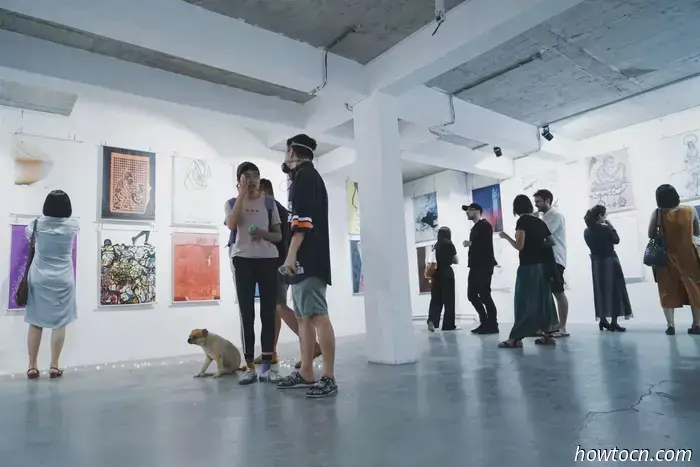
More than ten years ago, we introduced our audience to a new venue in Beijing: Aotu Space, situated at 67 Beixinqiao Toutiao, which served as an experimental art venue. Founded by Ray Wu, the early days of Aotu were curated by Spanish artist Pilar Escuder, who sought a platform to present her own work alongside other designers. This creative space quickly evolved into a focal point for the diverse and dynamic artistic community in Beijing.
My recollections of Aotu are filled with numerous art exhibitions, performances, screenings, and markets, including a launch event for Spittoon Literary Magazine. In addition to the art, one could always enjoy a fantastic gin and tonic at Aotu. On warm summer evenings, patrons often found themselves on the rooftop, gathered around Aotu's Chinese toon tree, taking in the relaxed atmosphere of Beijing's hutongs within the Second Ring Road.
Unfortunately, nothing lasts forever. On March 30, Aotu bid farewell to Beixinqiao “with a heavy heart,” embarking on a new transitional chapter. While Wu and his team may have lost their physical location, they are determined not to cease their mission; they are actively searching for new spaces to maintain their vibrant spirit.
I have no doubt that new venues will emerge in Beijing. However, it is disheartening to witness the disappearance of spaces that supported independent art and culture; just last month, Dada and Fruityspace announced their closures as well. In light of these ongoing and sporadic closures, I firmly believe it’s important to honor the stories of the entrepreneurs who have significantly shaped the local artistic landscape.
Ray Wu, known for Aotu, has always presented as a reserved and succinct individual. In this interview, I had the opportunity to gain insight into his vision regarding the past, present, and future of a project that has greatly influenced his life and work in Beijing. Ray's reflections reveal a genuine pride in Aotu's accomplishments, but what intrigued me most was his candid honesty and clarity regarding the nature of art—a topic that can often seem abstract. So, dear reader, let’s pause for an insightful conversation. We owe it to those who tirelessly shape Beijing into the city we cherish.
Hello, Ray. We truly appreciate your presence during this pivotal moment. What led you to close the doors at 67 Beixinqiao Toutiao, and what significance do you attach to this farewell? Hello, it’s my pleasure. Our lease ended, and we chose not to renew it. The meaning behind that choice is straightforward: we need to find a new location and embark on a new journey.
The end of a lease signifies the end of an era, a sentiment we've sadly heard before. I would love to hear more about the influence Aotu had on the art community and local society over the past decade. You insist the essence of the venue will persist… This is a crucial point. It’s true that Aotu no longer exists in a tangible form for now, but I believe that what truly endures is the spirit of a place, manifested through a network of memories and relationships. This holds particularly true in the art world. Physical locations are ultimately fleeting; they rely on a spirit that can be transferred elsewhere.
Over the past decade, Aotu primarily served as an incubator for ideas and connections, as well as a space for experimentation. Many emerging artists used Aotu as a platform for free expression, fostering intersections of ideas and cross-border collaborations. As facilitators in the art realm, we witnessed the growth of numerous creative pursuits, practices, and cultural movements. Additionally, we became a communal space for like-minded individuals to gather and build a shared cultural identity.
Most importantly, I believe we forged a relationship built on trust—with both our artists and our audience. Artists felt understood in their practice at Aotu, and our public undoubtedly came hoping to encounter something unique within our walls. It is this intangible network that endures, connecting us all and eventually reemerging in new and more decentralized forms.
That’s a profound reflection. Without overshadowing it, do you have any updates regarding a new location? We haven't yet found a suitable venue and would greatly appreciate any suggestions from the community for a space between 100 and 300 square meters that could accommodate exhibitions, salons, and events. In the meantime, we remain open to collaborations with cultural institutions, brands, and art space operators in Beijing.
To the people of Beijing: how do you envision the future of Aotu? In what ways will it differ from the Beixinqiao chapter? At Beixinqiao, we aimed to avoid becoming an “ivory tower.” Instead, we integrated ourselves with our environment. Wherever we relocate, we will uphold this approach of continually redefining our understanding of what’s local. Ultimately, art serves as an essential, transformative tool to enhance our urban spaces, engaging with them in meaningful ways.
Content-wise, our future venue will undoubtedly emphasize







Ray Wu reflects on ten years of artistry and memories at 67 Beixinqiao Toutiao.